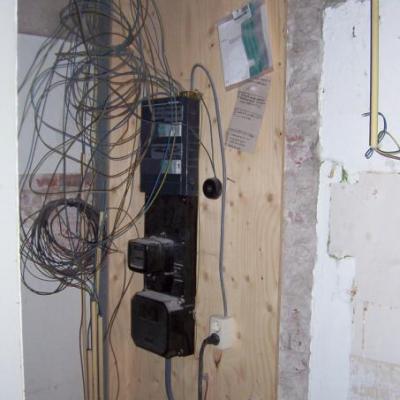Electrician (Elektricien)
Information on this skill...
An electrician is responsible for installing, modifying and maintaining electrical installations, which are necessary to use electricity safely. An electrician therefore ensures that users can use power in a safe way. The profession of electrician can be called a versatile profession, because as an electrician you not only have to deal with new installations, but also have to deal with adjustments and maintenance of electrical installations. In addition, as an electrician you usually do not only work in non-residential construction, because an electrician can also work in other ways. Consider, for example, the connection of heavy machines within the industry, which run on power current, or the installation of control panels. Working as an electrician is only reserved for the right professionals, who have the necessary knowledge and experience, because electrical installations can quickly become complex. In addition, it is important that an electrician installs installations according to the right regulations and with the right materials, so that no short circuits or other malfunctions can occur. As an electrician you are therefore an all-round professional in the field of electrical installations. This means that an electrician must be able to independently install, adapt and maintain all common electrical installations. Think, for example, of meter cupboards, intercom, video installations and the connection of machines. In addition, an electrician must be able to independently carry out all preparatory work, such as laying pipes and cables. The assembly and testing of electrical installations is also specifically part of the work of an electrician. The profession of electrician must also be seen as fairly general, because an electrician can also be specialized in different fields. For example, an electrician can only work within the industry.
An electrician is therefore an installer and mechanic of electrical installations, who must have a lot of technical knowledge. An electrician is generally employed with the larger electrical installations, such as meter cupboards, panels and machines. As an electrician, you regularly have to deal with assignments where there is no power yet. It is the electrician who ensures that the complete electrical installation is installed. An electrician does this, for example, by milling slots, placing pipes and pulling wiring. With new construction, it is important that an electrician can read drawings well. The working drawing shows all groups and the connection points where all sockets and light switches must eventually be placed. The electrician will have to mill slots in the walls to the place where the sockets come. When all the pipes are installed later, the electrician will pull the wiring through the pipes. These wires all run to the meter cupboard where they are connected to the right group. Installing the sockets and light switches is also a job for the electrician. When everything is ready, the electrician will measure the entire electrical system to make sure everything is working properly. In this way, the user of the building is assured of safe use. Understanding technical drawings is also important as an electrician.
ELECTRICITY OLD BUILDINGS
An electrician will also regularly have to deal with old existing situations. This may involve an electrician having to deal with old wiring, iron pipes and bakelite switches. Nowadays, only P.V.C. tubes are used to extend the wiring. In the past, these tubes were made of iron, so it is easy to short-circuit when a wire is exposed. Because old houses almost always consist of beam constructions, the risk of fire is present in the event of a short circuit. This is especially the case if the group in question does not strike out. These types of old installations can be better replaced to prevent problems. Those who have old wiring may come across other colors of wire. What is very insidious is that one is inclined to think that on the color red is the tension, which is not correct. So it is good to pay attention with old wiring. It is important to always be careful with electricity. There may have been unexperts at work before, who confused the colors. Then it can happen that there is voltage on the wrong wire. This is not easy to see with the naked eye. Another important point is to check whether an electrical installation has soil. Most houses still have the earth connected to the water pipe. Nowadays this is no longer possible, because the water pipes are made of plastic. In these cases, it is necessary to smash an earth tube of heavily galvanized steel into the ground. An electrical installation that does not have earth can be life-threatening. Consider, for example, electrocution while showering in the bathroom. A bathroom and other damp areas should be grounded.
TIPS FOR INSTALLING ELECTRICITY
Be careful when applying flexible pipes, because pulling wires into flexible tubes is not easy. This is mainly because flexible tubes are not smooth on the inside. In extreme cases, the floor or ceiling is closed and the electrician is unable to pull the wires. This is especially the case if the tube is in a too tight bend. Also make sure that the tubes are tightened enough to prevent the tubes from pulling off during wire pulling. Especially with couplings, such as bends, pipes can occur to pop loose. Pulling wires through a tube is done with a tension spring. Make sure that all the wires in a tube are pulled at once, because one by one it is not possible to do. This is best done by stripping the wires in part and then buttoning the spring with a thin knot. In most cases, pulling wires is best done by two people. One person pulls and the other pulls the wires.
JOIN GROUPS
Do not connect a washing machine, deep fryer or oven to the same group. If these are on together, the group will undoubtedly turn out. The houses in the Netherlands are secured with a maximum of sixteen amps, because the wires have a diameter of 2.5 mm. This means that the pipes of a home installation may be loaded with a maximum of 3500 W. This is a current of up to sixteen amps at a voltage of 220 V.
WHAT ARE ELECTRICAL INSTALLATIONS
The term electrical installations is a collective term for all installations and devices that run on electricity, including all installations and connections that are necessary for them to operate safely. Electrical installations occur everywhere in different ways, and not just in buildings. Think, for example, of electrical installations on board cars, ships and planes, and of machines. Without properly functioning electronics and electrical installations, these installations cannot run safely. Electrical installations can be simple, but also complex. The complex electrical installations can usually be found in large factories, which use heavy machinery. The relatively simple electrical installations can usually be found in homes. Especially the installation of complex electrical installations is better left to an experienced electrician. As an electrician, there is really only one thing that is really important and that is that installations are automatically switched off if they are used in an unsafe way. This may mean, for example, that one or more groups automatically switch off if too much power is taken or as soon as a short circuit occurs.
MODERN COLOR WIRES AND FEATURES:
- Brown is the phase (current)
- Blue is the neutral (zero wire)
- Black is the switch wire
- Yellow-green is the earth
OLD COLOR THREADS AND FEATURES:
- Green is the phase (current)
- Red is the neutral (zero wire)
- Black is the switch wire
- Grey is the earth
WHAT DOES AN ELECTRICIAN DO:
ELECTRICIAN TRAINING
You can become an electrician by following the electrical engineering and electronics course. During the training, the basic techniques of electronics are first learned, and one gradually goes deeper and deeper into the profession and a direction will also have to be chosen. This is because with the electrical engineering and electronics training there are several possibilities such as, home electrician, marine electrician and electrician for industry. Various directions and specializations are also possible in the construction industry, such as in the field of security. During the training, the student electrician will work four days in practice and go to school for one day, where the theoretical part will be taught. In addition, there are also plenty of external training institutes where you can follow a course. Accounting is also important as an electrician.
COMPANIES WHERE AN ELECTRICIAN CAN BE EMPLOYED
An electrician can work for different companies. Think, for example, of home installers, security companies, workshop designers and shipbuilders. The profession of electrician is also common within the industry. In that case, we are usually talking about an electrical engineer. An electrician who has a bachelor's degree can be regarded as an electrical engineer. In addition, an all-round electrician can work well as an entrepreneur.
COMPETENCES ELECTRICIAN
The most important competence of an electrician is the professional knowledge. In addition, an electrician must have a great sense of responsibility, because installations must be reliable in all cases. This may mean, for example, that an electrician has to reject an old installation, because the installation in question is not safe to use. In such cases, an electrician will have to consult with the client. An electrician will therefore have to have good communication skills, because an electrician must regularly consult about the work. Further training is also an important competence, because an electrician has to deal with a lot of new technology. Nowadays, this also relates to the necessary ICT knowledge. Generally important words are innovation, flexibility, planning, organizing, advising, insight, safety and inspection.
LABOUR MARKET PERSPECTIVE AND CAREER OPPORTUNITIES AS AN ELECTRICIAN
The labour market perspective of an electrician is good. An electrician who has the right training can work for different companies. Most installation companies are eager for good electricians. An electrician will therefore have no difficulty in obtaining work. The career opportunities of an electrician should be seen in obtaining more responsibilities. Consider, for example, the position of work planner. Starting your own business can also be regarded as growing within your career.
TERMS OF EMPLOYMENT AND SALARY ELECTRICIAN
An electrician will generally fall under the collective labour agreement technical installation company, in which the employment conditions are regulated depending on the employer. An electrician will generally earn a salary between 2000 and 2600 euros gross per month depending on age, education and further responsibilities. As an electrician, you will generally also have to run breakdown services on a regular basis. In most cases, a self-employed electrician works with a fixed hourly wage.
The content on this page has been automatically translated from the Dutch language. For this reason, texts and videos on this page may contain small errors.
Lesen Sie diese Informationen auf Elektriker auf Deutsch.
Lea esta información sobre Electricista en español.
Lees deze informatie over Elektricien in het Nederlands.
Mijnzzp.nl


